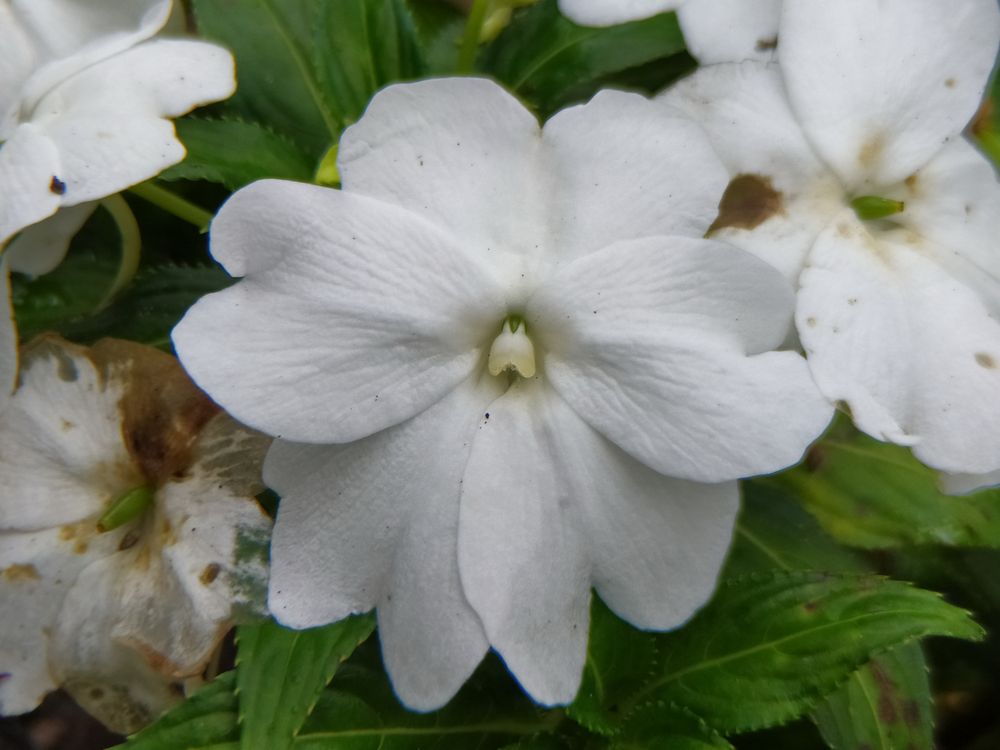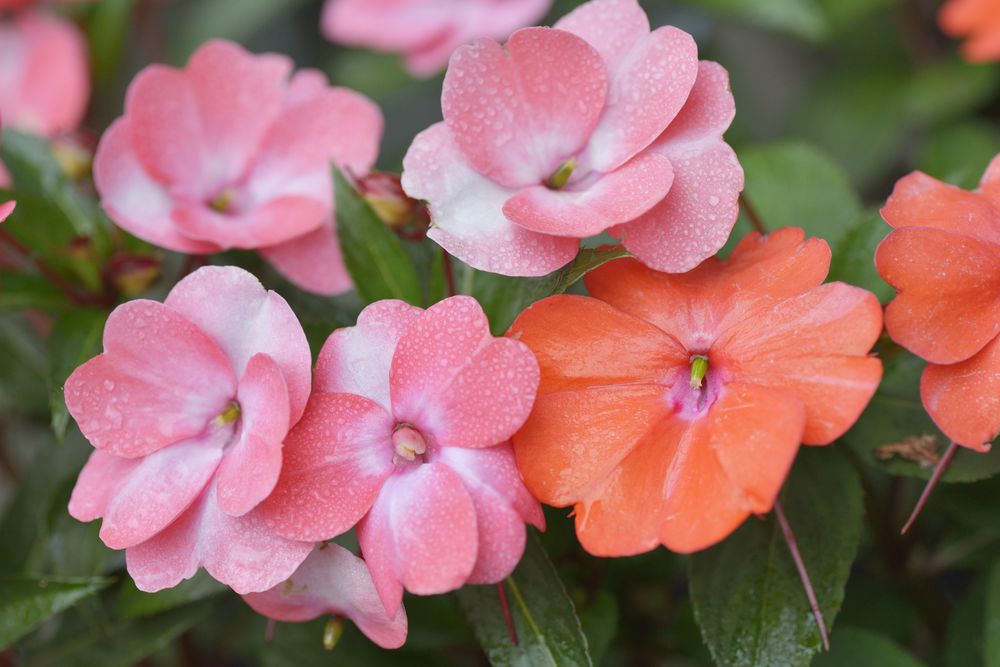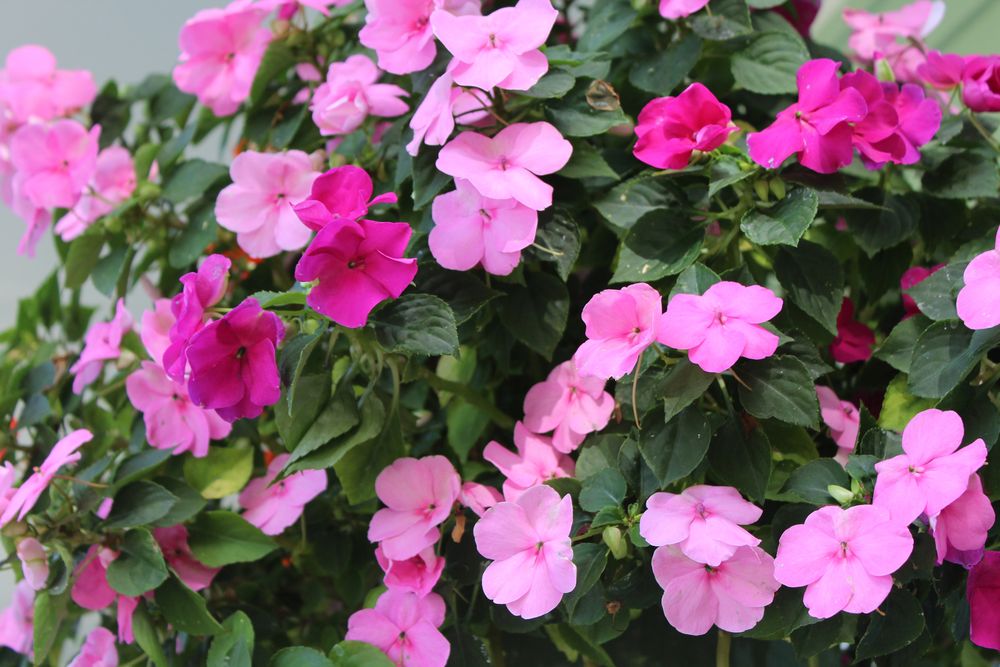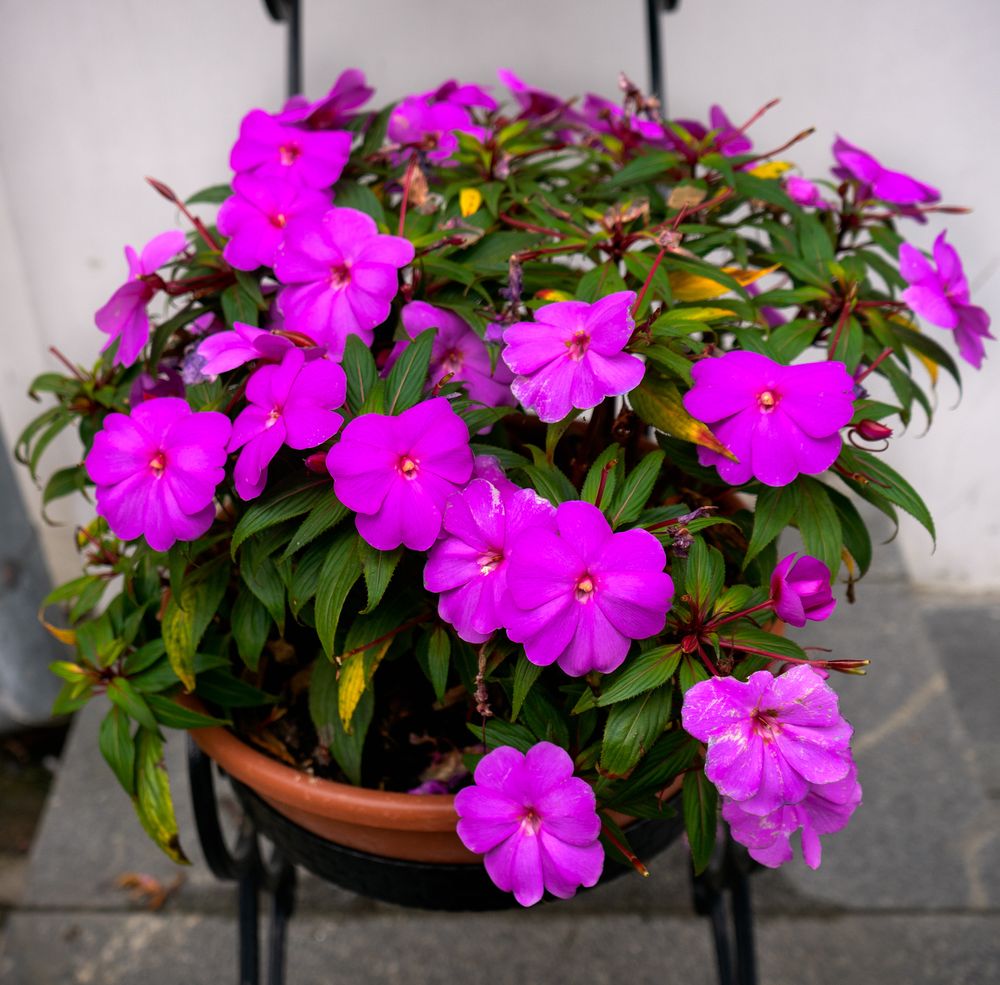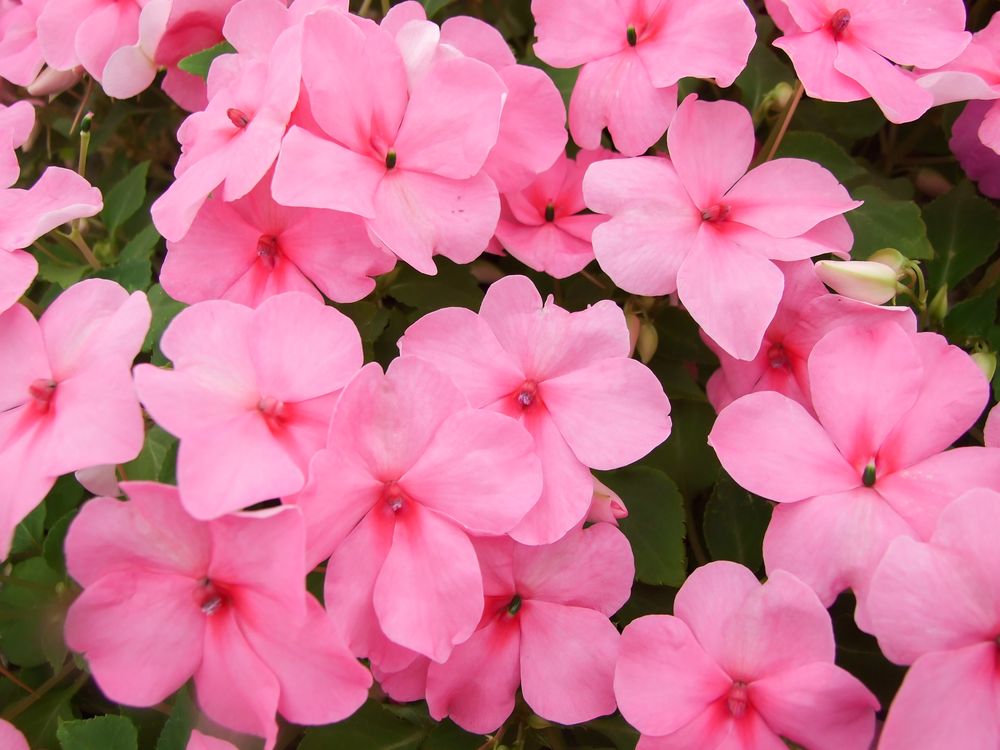7 Stunning Impatiens Varieties With Downy Mildew Resistance
If it weren’t for downy mildew, impatiens would be the undisputed queen of houseplants and shade gardens. This fungal infection decimates the plant in record time and leaves it a shadow of its glorious former self. And since it lurks in the garden soil for years, once a plant is infected, you won’t be able to grow impatiens again in that spot for many years to come.
Unless you choose impatiens varieties with excellent resistance to downy mildew. Yes, those varieties do exist and they are no less beautiful than the other varieties either. Read on to find out the difference between regular and disease-resistant impatiens and which varieties to grow in your garden or home.
Regular Impatiens vs New Guinea Impatiens
Regular impatiens are the natural species and varieties of impatiens that grow naturally in the wild. They’re known for being shade plants with dense foliage and rich vivid flowers. But they also fall prey to downy mildew quite easily.
New Guinea impatiens, on the other hand, are hybrids with high resistance to diseases including downy mildew and sun exposure. So if your garden gets flooded with sunlight throughout the spring and summer, you can still grow these impatiens hybrids. This explains why New Guinea impatiens are sometimes called “sun impatiens.”
But that doesn’t mean that you should let them get the full sun all day long. That can impact their growth and flowering. Some partial shade in hot zones is recommended in the afternoons.
Besides that, the New Guinea impatiens are easy to grow from a cutting. Starting them from seeds is a bit unpredictable as with most cultivars. The leaves are usually larger than the natural species and the blooms of the cultivars can reach up to 3 inches in diameter.
As for the leaf colors, the cultivars have green, purple, or bronze leaves and some varieties have variegated leaves. The mature cultivar reaches anything from one to two feet at most.
It’s clear that the New Guinea impatiens cultivars have a lot going for them. They have more ornamental values, can tolerate sunlight, and resist fatal diseases such as downy mildew. For all of these reasons and more, we’ll focus here on the top varieties of New Guinea impatiens.
Impatiens Varieties
The following cultivars have different growing conditions from full sun tolerance to full shade. They also offer varying ornamental qualities and their blooms range from red, violet, and salmon to cream, white, and golden. Check the hardiness zone of each cultivar before you plant it in your garden.
Bounce Violet
Although technically a New Guinea impatiens hybrid, the Bounce Violet adds strains from many impatiens species that grow in the tropics to its gene pool. This makes the cultivar highly tolerant to shade and light conditions and improves its resistance to diseases. While other impatiens would be falling left and right to downy mildew, the Bounce Violet keeps growing untouched by the fungus.
As for the name it refers to two qualities that set this cultivar apart from other varieties. The first is the color of the blooms. The flowers are usually purple which under a certain light comes off as violet. The leaves are dark green and long although, in the bloom season, most of the leaves will hide behind the flowers.
The other quality is the plant’s ability to bounce back to life after long exposure to the sweltering heat of the sun in the summer. Just when you thought the cultivar has wilted and there’s no coming back from that, as soon as you move it to a shady area it grows back and continues as if nothing has happened.
You can grow the Bounce Violet as a perennial in zones 10 and 11. In zones below 10, it grows as an annual. It prefers partial to full shade over full sun and averages between 15 to 21 inches.
Spreading Shell Pink
This hybrid comes straight from Japan. So you can expect it to be well-behaved, self-sufficient, and low-maintenance. While the mature plant averages anything from 18 to 48 inches, it has a slow growth rate and remains within the boundaries of the container. Many people grow the Spreading Shell Pink in hanging baskets where regular pruning keeps the hybrid in wonderful shape all year round.
This cultivar has a higher tolerance to heat and humidity than many other New Guinea impatiens on this list. So if you live in the heat-soaked Florida Keys or Southern California, you can grow the Spreading Shell Pink as a perennial. Moreover, the hybrid is not as particular about the shade requirements as other impatiens. Full sun will not harm the plant or cause it to wilt. Nor does high humidity. And when you add its resistance to the dreaded downy mildew, you know you’ve got your impatiens answer to hot and humid microclimates.
The blooms of this cultivar are salmon-colored and reach about 3 inches in diameter. The plant requires little feeding and the watering quota is around one inch a week.
Bounce Pink Flame
Since the Bounce series has proven itself as a worthy impatiens, you can grow many hybrids with different colors and enjoy a vibrant shade garden all spring and summer long. The first thing that strikes you as unusual and unique about this award-winning cultivar is the pink shades. It’s rare to get these pink hues in a single flower. But that’s what hybrids do best. They excel over the work of mother nature.
Another advantage of the Bounce Pink Flame is its longevity. It has an exceptionally long blooming time. The flowers also have a long vase life and stay fresh for weeks. But perhaps the most appealing feature of this impatiens cultivar is its resistance to downy mildew. You can grow it as a perennial for years without having to worry about this fungal infection destroying your meticulous handiwork.
But that’s not all. If for some reason you don’t like pink and prefer other more subdued colors. This hybrid comes in a variety of white and coral, and ravishing cherry blooms as well.
Much like the rest of the Bounce family, this hybrid grows in partial to full shade, is a perennial in zones 10 and 11 and annual elsewhere, and averages between 15 to 21 inches tall.
Divine Mix
Whoever named this impatiens hybrid had the soul and sensibility of a poet. The Divine Mix is a showy New Guinea impatiens cultivar with flowers that bloom all summer long. But unlike many cultivars on this list, this one can be started from seeds. That makes it a lot easier to grow the plant in your garden since seeds are cheaper and easier to transport than cuttings.
The seeds have a good germination success rate and the resulting plant is identical to its parents. As for the flowers, they’re not as large as the Bounce family hybrids but they come in different colors. I don’t mean that different hybrids produce different blooms. A single Divine Mix plant will produce blooms of many colors ranging from maroon to pink, salmon, and rose. Some flowers will have blushes of red on a background of yellow or vice versa.
The Divine Mix is a crossbreed between two impatiens native to the Solomon Islands and New Guinea. They thrive in a shade garden in zones 10 to 11 as a perennial but in cooler zones will grow as annuals. The average height of the mature plant is about 14 inches and it prefers partial shade over sunny spots.
Compact Pink
There’s nothing compact about the Compact Pink. Neither the mature plant nor the showy blooms indicate that the cultivar is compact in any way. If anything it’s the exact opposite. This is the kind of cultivar to tower over 3 feet tall which makes it a giant by impatiens standards.
Of course, you can grow it in a pot and prune it to keep its size manageable. Allowing the potted hybrid to reach 3 feet tall is just asking for trouble. It’s hard to care for a plant that high and if you grow it as a perennial, then you’ll need to repot it once a year just to accommodate those robust roots.
But the other half of the name is quite true. The flowers of this hybrid are deep pink. Their pinkiness is on the delicate and exquisite side. And since the blooms grow to about 3 inches wide, that splash of pink in your garden becomes the focal point throughout the summer.
And you don’t have to worry about the damaging effect of the full sun on this plant. It thrives both in full sun and partial shade. Just keep it away from full shade since it needs a few hours of sunlight in the spring and summer.
The Compact Pink is a heavy feeder and needs about 1.5 inches of water a week if it grows in a sunny spot. Side-dress it with a slow-release fertilizer to keep it happy during the growing season.
Florific Sweet Orange
When you get tired of all those blocks of brash and loud colors, the Florific Sweet Orange is waiting for you around the corner. Its orange multi-colored blooms wink at you and then you’ll know you’re hooked.
With dark green leaves that barely make a show all summer, this cultivar is all about the small flowers that bring about a good balance between cheerful colors and subdued tones. It’s the perfect plant for the living room as well as the patio or deck. Punctuate your corners with pots of this hybrid to add a subtle gesture of class and sophistication to your property.
And if the suave colors of the flowers won’t sway you, consider that they stay in bloom from the late spring until the first frost. However, you’ll need to deadhead them once a month to encourage new flowers to grow. The blooms attract pollinators from bees to hummingbirds and butterflies.
The average plant grows to about 10 inches which makes it ideal as a potted plant or in a hanging basket. It has a way of forming ball-shaped foliage that spills over the sides of the container. The Florific Sweet Orange has little tolerance to the sun or partial sun. So grow it in partial to full shade.
Florific White
Another member of the Florific series. This one has all the advantages of the Florific Sweet Orange but its blooms are pure white. White is not a very popular color in the impatiens world. People are attracted to the splash of red, pink, and purple more than white. But the Florific White will make you change your mind.
Especially when the rest of the garden is resplendent with colors. A corner of white blooms creates harmony in the garden. And since it is easy to start this cultivar from seeds, you won’t have a problem getting seeds online or from a reliable store that you trust.
The Florific White has good tolerance to shade and full shade and is not particular about the type of soil you grow it in. As for watering, it needs less than an inch of water a week during the spring and summer. If you get a decent rainfall, then you won’t have to water it at all. It’s hardy to zones 10 and 11 but will not thrive in cooler zones. So grow it as an annual and save the seeds to start it again next spring. The mature plant averages anything from 10 to 14 inches tall.
